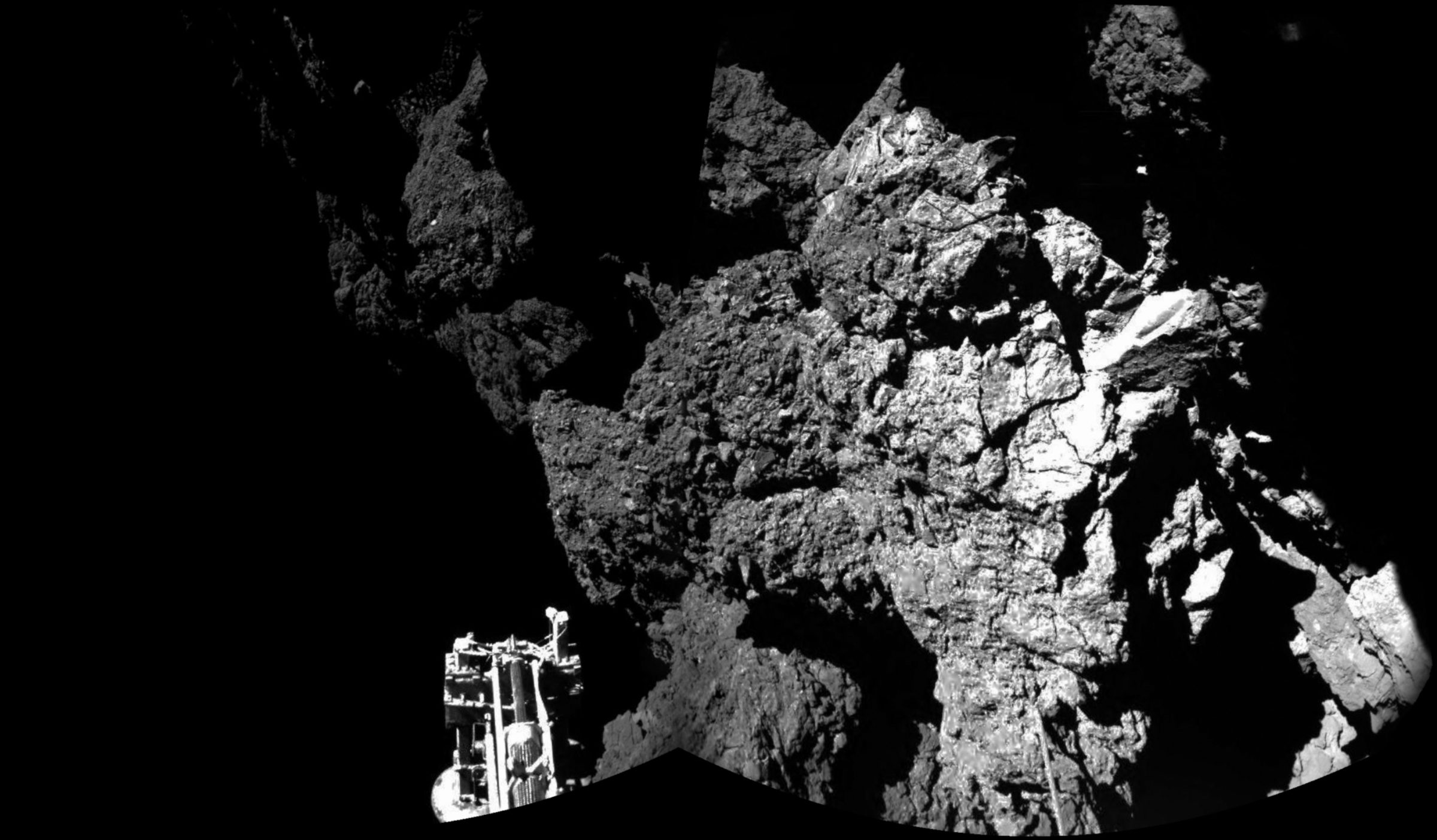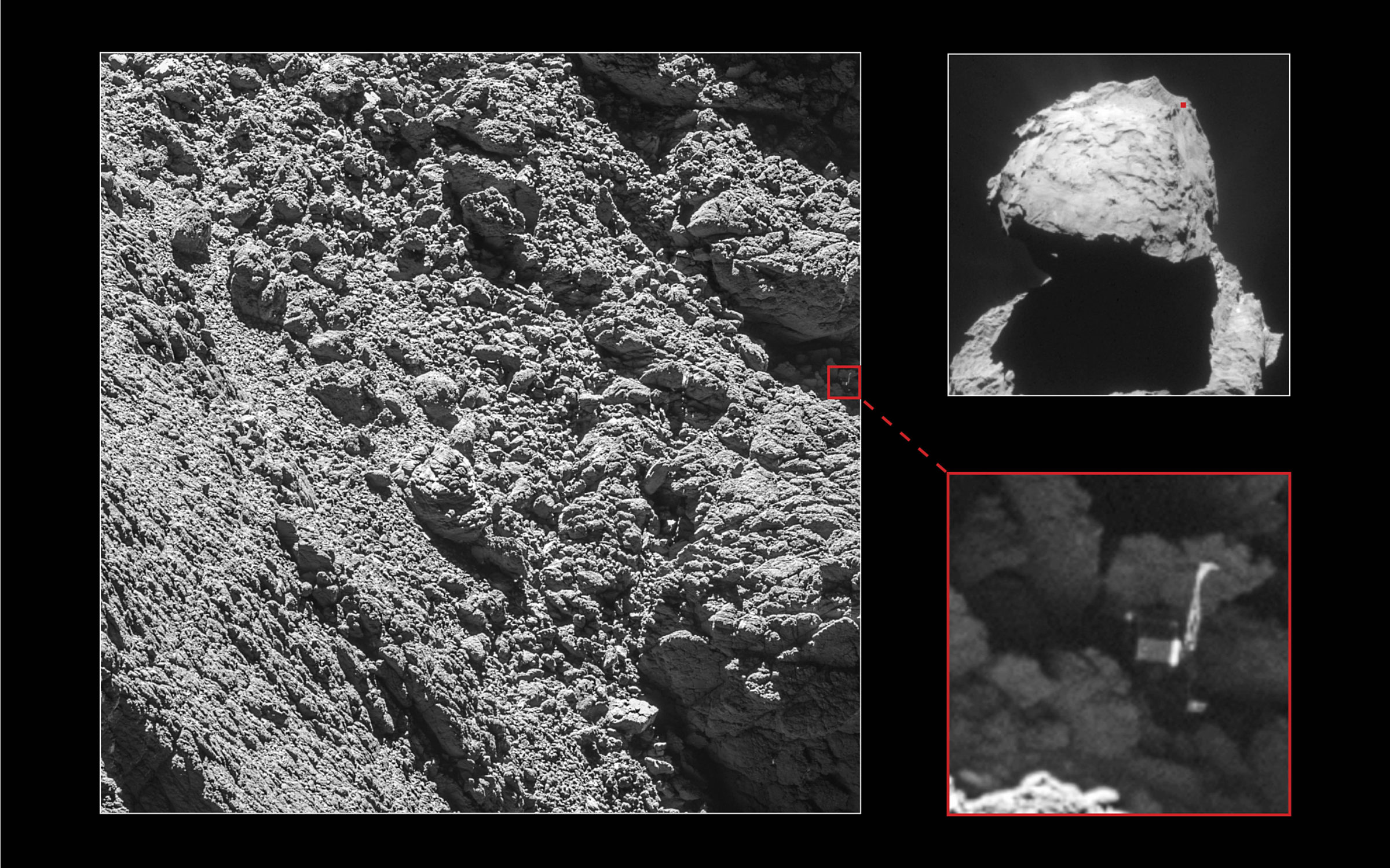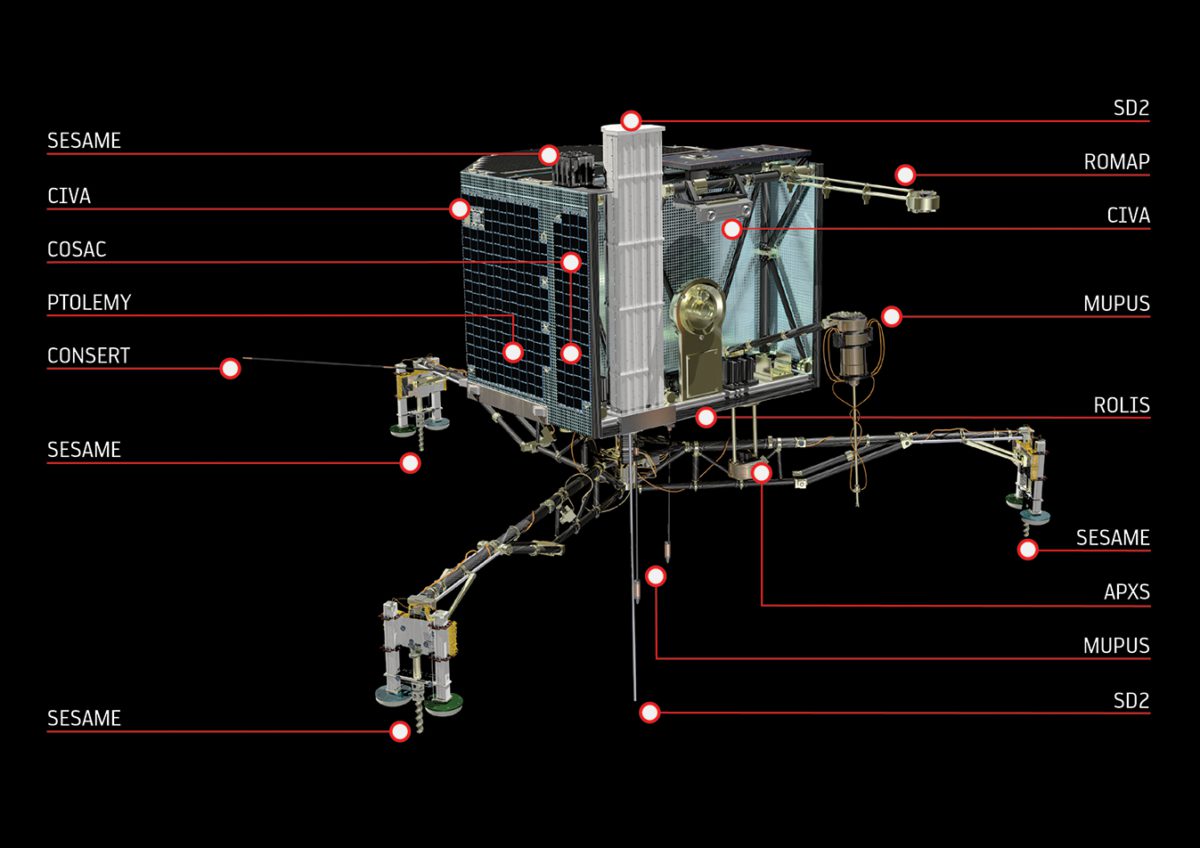Emily Lakdawalla • May 09, 2018
Philae science results: Comet 67P is crunchy on the outside, soft on the inside
What is the surface of a comet like? That's one of the main questions that motivated Philae's mission to the surface of comet 67P/Churyumov-Gerasimenko. That question now has an answer, at least for the spot immediately below Philae: there is a rigid crust about 10 to 50 centimeters thick, below which the comet is much more fluffy. The rigid crust is a mixture of ice and regolith, just barely held together by ice grains sticking to each other. There may possibly be a thinner, stronger crust just a centimeter thick that frustrated the penetration of Philae's instruments into the comet.
The results came out in Icarus, the peer-reviewed journal associated with the American Astronomical Society's Division for Planetary Sciences, in an article titled "Structure and elastic parameters of the near surface of Abydos site on comet 67P/Churyumov–Gerasimenko, as obtained by SESAME/CASSE listening to the MUPUS insertion phase," by Martin Knapmeyer et al.
As a reminder, here is what the landing site looked like to Philae: a strikingly rugged surface, with stiff, strong material sticking up in plates, fractured through and through.

Why is the structure of a comet's surface interesting, beyond mere curiosity? Comets are thought to be primordial, relics of solar system formation. They're made of a mixture of materials, including asteroid-like dust and carbonaceous stuff, along with various ices. They agglomerated more than 4.5 billion years ago as the solar system was forming, but never grew very large, mostly not large enough for self-gravity to compress their substance tightly together. As a result, they're incredibly porous, their component grains barely touching around huge voids. 67P has a density of 533 kilograms per cubic meter, barely more than half the density of water ice. If it were all ice, half of its volume would be empty space. But the Rosetta CONSERT radar sounding experiment showed 67P is 75 to 85% empty space. Look at the pictures of the surface, though: no great gaping voids, but an apparently solid surface. How to reconcile those two things?

Although their insides are primordial, the outsides of comets whose orbital paths take them into the inner solar system have seen a lot of change. Cometary activity happens when comets get close enough to the Sun for some of their icy material to vaporize into gas; the expanding gas flies off the comet, sometimes in collimated jets, much of it never to return to the surface. Some of the dust goes with the gas in cometary jets, but other dust falls back to the comet surface, and some is left behind as a lag deposit. The process changes the surface of the comet in some way, but how exactly?
Before Philae, we wondered: What is the surface like? Is it made of a dust-particle snow with a very poofy texture like powder snow? Is it sticky and compressible, like fresh snow? Does it have some strength but is compressible, like styrofoam? Or is it strong and dense like ice or rock? Understanding the nature of the cometary surface would help scientists develop models for how and why comets have jets, how activity begins and ends, how long comets are active before becoming dormant, and would even help engineers figure out how to safely land a bigger spacecraft on a comet.

The MUPUS experiment
MUPIS stands for Multipurpose Sensors for Surface and Sub-Surface Science. It was planned to drive a self-hammering rod into the surface of the comet to measure its properties, but because of the weird landing of Philae in a crevice, the rod never actually penetrated into the surface. But MUPUS did reach and touch the surface, and as it hammered itself multiple times, it generated acoustic bangs that a different instrument, CASSE (Comet Acoustic Surface Sounding Experiment, itself part of the SESAME instrument), could pick up through three-axis accelerometers in Philae's feet. The bangs traveled through comet material first before reaching the feet, jostling CASSE's sensitive accelerometers. (You might wonder, as I did, whether the bangs detected by CASSE were just traveling through the spacecraft to the accelerometers, but the researchers demonstrated that the arrival times of the waves were not simultaneous, so were traveling a longer path length than just through tiny Philae.) Knapmeyer and coworkers calculated the velocity by which the waves propagated through the comet, and from that, deduced the physical properties of the comet's surface, after they'd made a few assumptions.

APXS: Alpha Particle X-ray Spectrometer, for studying elemental composition
CIVA: Comet Nucleus Infrared and Visible Analyser, six black-and-white cameras for panoramic imaging
CONSERT: COmet Nucleus Sounding Experiment by Radiowave Transmission, for studying comet interior
COSAC: The COmetary SAmpling and Composition, an evolved gas analyzer for identifying organic molecules
Ptolemy: an evolved gas analyzer for measuring isotopes of light elements
MUPUS: MUlti-PUrpose Sensors for Surface and Sub-Surface Science, for studying comet physical properties
ROLIS: Rosetta Lander Imaging System, will provide context images of landing site
ROMAP: Rosetta Lander Magnetometer and Plasma Monitor, for studying the magnetic field and plasma environment of the comet
SD2: Sampling, drilling and distribution subsystem, can drill to 23 centimeters depth
SESAME: Surface Electric Sounding and Acoustic Monitoring Experiment, for studying comet physical propertiesImage: ESA / ATG medialab
The CASSE accelerometers actually recorded four different arrival times for waves associated with each MUPUS bang; the arrival times were different for different wave frequencies. This behavior is a telltale property of layered materals -- longer-wavelength waves "feel" deeper into a surface than shorter-wavelength waves. Assuming a simple two-layer structure, Knapmeyer and coworkers found that the waves traveled roughly twice as fast in the near-surface layer as they did in the deeper layer, and that the upper layer was 10 to 50 centimeters thick. Waves travel faster in stiffer materials, so there is a stiffer crust 10 to 50 centimeters thick over a much less stiff interior. The comet is crunchy on the outside and soft on the inside, but the crunchy layer is pretty thin. The crunchy layer must develop fast whenever activity exposes fresh comet interior, because the comet loses several meters' worth of substance on every perihelion pass around the Sun, every 6.5 years.

Postscript: this paper includes nearly half a page spent defining what "dust" means to comet scientists, which points out that "there are at least three different definitions of the term 'dust'" in active use. "Dust" is therefore one of those words like "sand" and "haze" (or even "rock" or "ice" or "metal") that trip scientists up; it seems so common a word that it doesn't need defining, but takes on precise meanings in scientific contexts.
Support our core enterprises
Your support powers our mission to explore worlds, find life, and defend Earth. You make all the difference when you make a gift. Give today!
Donate

 Explore Worlds
Explore Worlds Find Life
Find Life Defend Earth
Defend Earth

